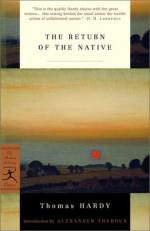The most thorough-going ascetic could feel that he had a natural right to wander on Egdon: he was keeping within the line of legitimate indulgence when he laid himself open to influences such as these. Colours and beauties so far subdued were, at least, the birthright of all. Only in summer days of highest feather did its mood touch the level of gaiety. Intensity was more usually reached by way of the solemn than by way of the brilliant, and such a sort of intensity was often arrived at during winter darkness, tempests, and mists. Then Egdon was aroused to reciprocity; for the storm was its lover, and the wind its friend. Then it became the home of strange phantoms; and it was found to be the hitherto unrecognized original of those wild regions of obscurity which are vaguely felt to be compassing us about in midnight dreams of flight and disaster, and are never thought of after the dream till revived by scenes like this.
It was at present a place perfectly accordant with man’s nature—neither ghastly, hateful, nor ugly; neither commonplace, unmeaning, nor tame; but, like man, slighted and enduring; and withal singularly colossal and mysterious in its swarthy monotony. As with some persons who have long lived apart, solitude seemed to look out of its countenance. It had a lonely face, suggesting tragical possibilities.
This obscure, obsolete, superseded country figures in Domesday. Its condition is recorded therein as that of heathy, furzy, briary wilderness—“Bruaria.” Then follows the length and breadth in leagues; and, though some uncertainty exists as to the exact extent of this ancient lineal measure, it appears from the figures that the area of Egdon down to the present day has but little diminished. “Turbaria Bruaria”—the right of cutting heath-turf—occurs in charters relating to the district. “Overgrown with heth and mosse,” says Leland of the same dark sweep of country.
Here at least were intelligible facts regarding landscape—far-reaching proofs productive of genuine satisfaction. The untameable, Ishmaelitish thing that Egdon now was it always had been. Civilization was its enemy; and ever since the beginning of vegetation its soil had worn the same antique brown dress, the natural and invariable garment of the particular formation. In its venerable one coat lay a certain vein of satire on human vanity in clothes. A person on a heath in raiment of modern cut and colours has more or less an anomalous look. We seem to want the oldest and simplest human clothing where the clothing of the earth is so primitive.




